I didn’t plan to come to Nicaragua—definitely not to Ometepe. It was a gap filler, a spontaneous side trip between bigger plans. But within a few hours of arriving, I realized this island might be the best detour I’ve ever taken.
Ometepe sits in the middle of Lake Nicaragua, built on the backs of two volcanoes: Concepción, tall and volatile, and Maderas, its calmer, jungle-covered twin. In between them, life moves slow. Mangoes drop like clockwork. Chickens roam the roads. Locals wave when they drive past—on foot, by horse, or in the occasional pickup.
It’s not a place you come to tick off highlights. It’s the kind of place where you forget what day it is.
How to Get to Ometepe
Ometepe was a stop between San Juan del Sur and Granada, just a few days to break up the trip. What I didn’t realize was that it would be one of the most unique places I’ve ever been.
The only way onto the island is by ferry from San Jorge, a small port town near Rivas. If you’re coming from San Juan del Sur, expect a 1-hour shuttle or taxi ride to the dock. From Granada or Managua, it’ll take 2-3 hours by bus or private car. If you’re coming from Costa Rica, crossing the border into Nicaragua can be surprisingly easy.
Ferries run multiple times a day and take about 1 hour to reach Ometepe. They drop you off at either Moyogalpa (the main town, better for renting transport) or San José del Sur (closer to quieter areas). The ride is cheap, under $5, but the boats range from decent to floating death traps with a motor. If you’re prone to seasickness, take the bigger ferry. Trust me. No need to book ahead—just show up 20-30 minutes before departure. You can see the ferry schedule here.
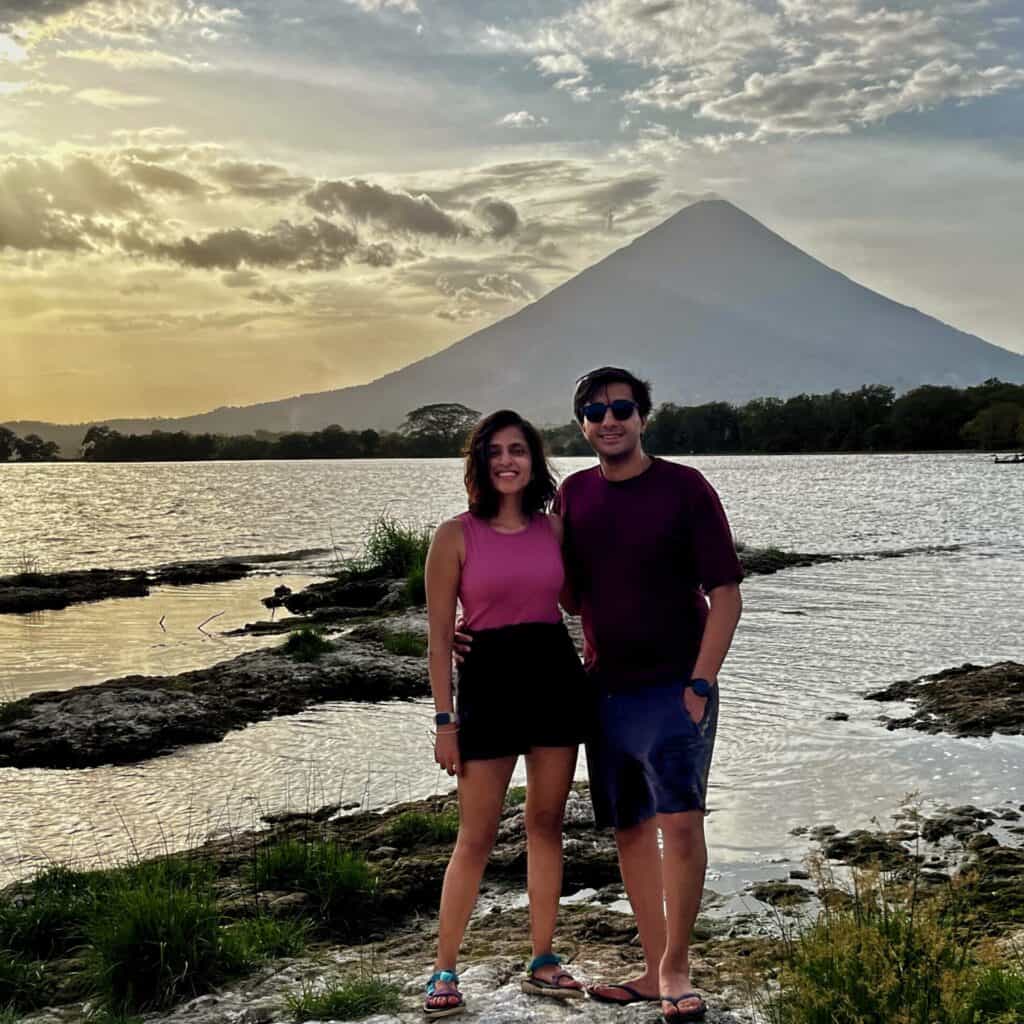
Getting Around Ometepe: Scooters, ATVs, and Roads That Might Break You
Once you’re on the island, the real adventure begins. I’d highly recommend you rend rent a motorbike or an ATV. This was, without question, the best decision we made. The roads on Ometepe range from paved to “was this ever a road?” and having an ATV meant we could go anywhere. And we did.
Here’s how you can get around:
- Scooter rental ($15-25/day) – Fun but challenging. Roads are rough, and if it rains, they become a muddy disaster.
- ATV rental ($50-70/day) – The best decision we made. Handles rough roads way better than scooters. Worth every penny. Most accommodations can help you rent one.
- Bicycle rental ($5-10/day) – Doable for short distances, but Ometepe’s heat and hills will destroy you.
- Local buses ($1-3 per ride) – Cheap but slow, unreliable, and only run on main roads a few times a day.
- Taxis ($10-30 per ride) – Expensive, especially for long distances.
Best Time to Visit Ometepe
Ometepe has tropical island weather, which means two things: it’s hot, and the rain does whatever it wants. Expect a mix of scorching sun, sudden downpours, and humid nights.
Dry Season (November – April) | This is when the island sees the most sunshine, clear skies, and dry trails—perfect for hiking, exploring, and getting around without worrying about muddy roads. That said, this is also when more travelers visit the island, so accommodation prices might be slightly higher. But don’t worry—Ometepe never really feels crowded.
Rainy Season (May – October) | Ometepe’s rainy season means more frequent downpours, muddier roads, and occasional ferry delays due to bad weather. If you’re into dramatic landscapes and don’t mind the rain, this could still be a great time to visit—just be prepared to get a little wet.
We visited during April, and the weather was all over the place. Some days were unbearably hot, but we always found shade. Other times, a thunderstorm rolled in out of nowhere, dumping rain for an hour before vanishing like nothing happened. Typical island weather.
17 Unique Things to Do in Ometepe
This isn’t the kind of island where you run around checking off must-sees. Ometepe rewards the slow traveler — the one who gets lost on purpose, lingers after sunset, and knows that sometimes the best plan is no plan at all. That said, if you’re looking for the island’s most memorable corners, here’s what I’d actually recommend. From quiet beaches and hidden mango trees to kayaking through flooded forests, these are the best ways to experience Ometepe — volcano-free or not.
3. Kayak through Río Istián
This was easily one of the best things I did on Ometepe. The Río Istián isn’t really a river—it’s a flooded wetland, shaped by the rising and falling of Lake Nicaragua. The entire area feels untouched, with thick mangroves, mirror-like water, and absolute silence.
Go with a guide. I can’t stress this enough. We booked with Caiman’s Tours for $10 per person, and the guide spotted things I would have never seen—a caiman perfectly camouflaged in the reeds, owls tucked into the trees, bright blue kingfishers darting over the water. Without him, I’d have just been paddling around in circles, missing everything.
Kayaking through Río Istián at sunset made the experience even better—the sky turned soft orange, the lake reflected the colors, and everything felt even more surreal.
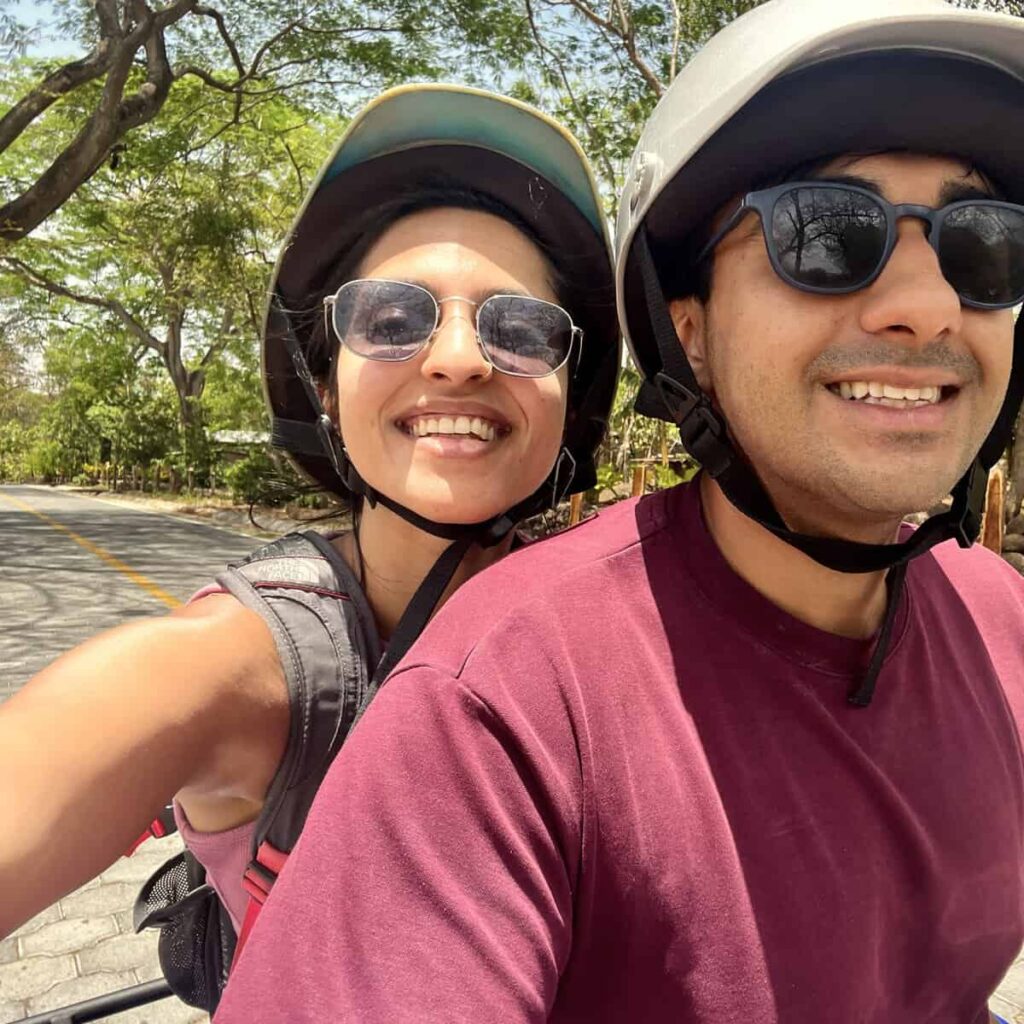

2. Find the Best Hidden Spot on Ometepe: Chilataya Beach
Some places on Ometepe are made for tourists. Chilataya Beach isn’t one of them.
We found this place by accident. No blog posts, no recommendations—just a random name on the map and a road that barely looked passable. So we went.
The ride? Brutal. The road turned from paved to dirt to rocks before vanishing into what barely counted as a path. We passed through tiny villages where kids ran after our ATV, waving like we were some kind of rare sighting. It felt like we had stumbled into a part of Ometepe that wasn’t expecting visitors.
And then, the road opened up to a long, empty stretch of black sand, wild grass, and nothing else. No hotels, no restaurants—just silence and the sound of the water. We stayed long past sunset, because how do you leave a place like that?No, you won’t find a bar serving cocktails here. But if you want an untouched, wild piece of Ometepe, this is it.
3. Hike up Volcán Maderas
After weeks of hiking in Argentina, I wasn’t exactly eager to haul myself up another volcano — especially not in tropical heat and Ometepe-level humidity. So no, I didn’t hike Maderas. And I’m not sorry.
But if you’re into lush jungle trails, sweaty climbs, and a crater lake at the top, this one might be worth the effort.
Compared to Concepción, Maderas is the quieter, greener sibling. The trail weaves through dense cloud forest where vines hang low and the air feels like soup. It’s steep, muddy, and full of moments that make you question your life choices — but people who’ve done it say the hike is beautiful, and the still, misty lake at the summit is a quiet reward.
4. Visit Ojo de Agua
Ojo de Agua is the perfect place to start your day. Everyone says to go in the afternoon when the sun is high, but by then, it’s crowded with tourists and day-tripping locals. We went as soon as it opened, and for a while, it was just us, the sound of the wind moving through the trees, and the still, mineral-rich water.
The pool itself is crystal clear, cold, and shaded by thick jungle. There’s a slackline across the middle if you feel like embarrassing yourself, and a few loungers if you just want to relax. We stayed for a couple of hours, and by the time we left, the place had completely transformed—noisy, packed, and the opposite of the nature escape we had in the morning.
If you actually want to enjoy it, go early.
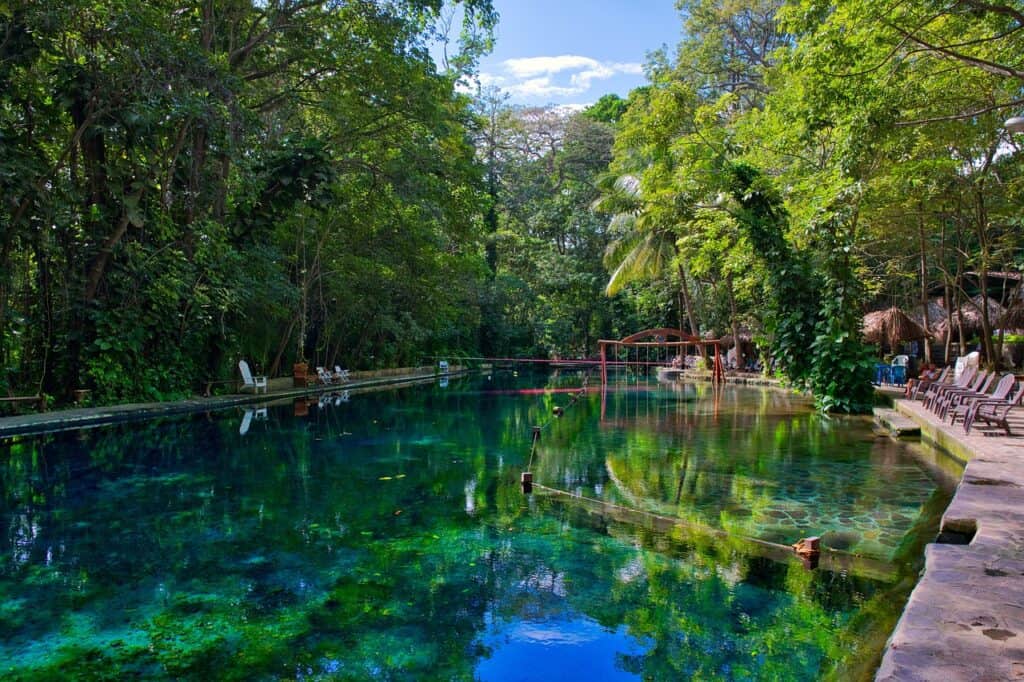
5. Swim on Playa Santo Domingo’s Black Sand Beach
This long, quiet beach sits between the two volcanoes and offers some of the calmest water on the island. The sand is soft but lava-black and gets hot enough to roast your feet, so bring sandals. We spent an afternoon floating in the lake with views of Concepción looming in the distance. There’s no surf, no crowds, and plenty of nearby spots for lunch or a cold drink.
6. Watch The Sunset At Punta Jesús María
Getting to Punta Jesús María is half the experience. The road starts off paved—a rare luxury on Ometepe—but quickly narrows into a dusty, tree-lined path that eventually opens up to the lake.
A long, narrow sandbank juts out into Lake Nicaragua, making it feel like you’re walking on water. On a clear evening, the sunset here is unreal—a golden sky, the silhouettes of both volcanoes reflected in the water, and the kind of view that makes you stop and just take it all in.
When we visited, a local festival was in full swing—food stalls, live music, and families everywhere. It wasn’t the peaceful sunset spot I had imagined, but it was an experience. We grabbed some food, walked along the sandbank, and watched the sun dip behind the horizon.
7. Hike Volcán Concepción (For the Hardcore Hikers)
Volcán Concepción is the taller and more dramatic of Ometepe’s two volcanoes — and also the more brutal. The trail is a steep, exposed grind up loose volcanic rock, with no shade and very few flat stretches. Toward the top, strong winds and slippery scree make the climb even more intense.
It’s the kind of hike that demands a guide (mandatory), proper gear, and a stubborn streak. But if you’re after sweeping views, an extreme challenge, and a solid story to tell, this might be your mountain.
8. Sip Cacao At El Pital Chocolate Paradise
El Pital is part eco-lodge, part chocolate haven, buried deep in the jungle near Balgüe. It draws in the kind of travelers who come for a cacao smoothie and end up staying for the hammocks and slow island life. The chocolate? Actually good—organic, rich, and just the right amount of bitter. They also offer cacao ceremonies, which are somewhere between a meditative experience and a straight-up caffeine rush. If you need a break from bumpy roads and dusty hikes, this is the spot to slow down for a few hours.
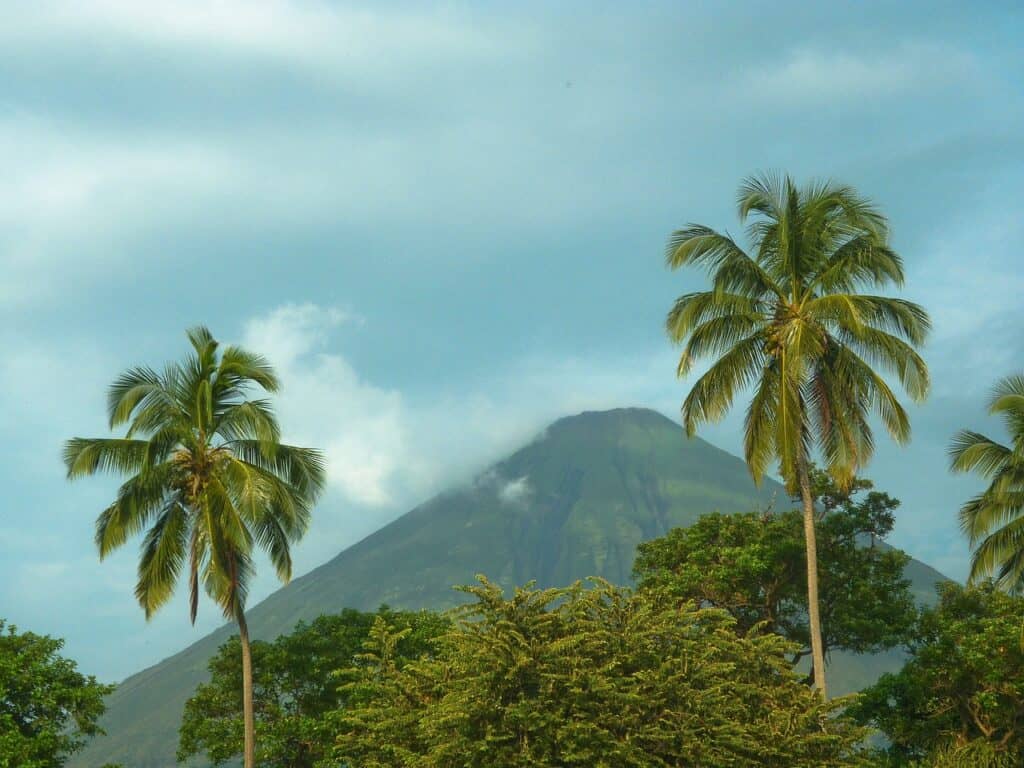
9. Unwind at Playa Santo Domingo
Playa Santo Domingo may get all the attention, but Playa Santa Cruz is the quieter, more laid-back option just down the road. It’s less developed, less crowded, and has a more local feel—the kind of place where you’ll see fishermen hauling in their catch while a few stray dogs nap under the trees.
The beach itself is small and rocky, not ideal for swimming, but perfect for a slow afternoon of doing absolutely nothing. Bring a book, grab a drink from one of the nearby restaurants, and watch the lake stretch out in front of you like an infinity pool.
11. Tour a Local Coffee Plantation & Hunt Ancient Petroglyphs at Finca Magdalena
Ometepe’s coffee plantations are tucked into the hills, and if you want to slow down, a visit to Finca Magdalena is the way to do it. The ride up is rough, but once you’re there, you get strong, bold coffee and unreal views over the island. The tour walks you through how the beans are grown and harvested, but honestly, sitting on the terrace with a fresh cup, watching the jungle disappear into the clouds, is the real highlight.
If you wander the trails nearby, you’ll stumble across petroglyphs—2,000-year-old carvings left behind by the indigenous Chorotega people. No ticket office, no signs, just spirals and figures etched into volcanic rock, a quiet reminder that Ometepe’s history runs deep.
12. Hike to San Ramón Waterfall
A 50-meter waterfall on the slopes of Volcán Maderas, San Ramón is nice, but not life-changing. If you have the time and want a solid jungle hike, it’s a good option. If you’re expecting something powerful and dramatic, you might be disappointed.
The hike is easy but long—about four hours round trip unless you have an ATV, which cuts the walking time significantly. The path winds through thick jungle, and while it’s nothing too intense, it gets rocky in parts. The waterfall itself is a thin, misty cascade, best seen after the rainy season when the water is actually flowing.
13. Learn About Ometepe’s History at El Ceibo Museum
I didn’t expect much from El Ceibo Museum, but it turned out to be surprisingly interesting. It’s split into two sections—one with pre-Columbian artifacts (pottery, tools, statues) and another on Nicaragua’s monetary history (random, but oddly fascinating).
If you’re into archaeology or just need a break from hiking, it’s a solid stop. You can also pair it with a visit to Altagracia, where more petroglyphs and artifacts are scattered through the town. Not an essential stop, but worth an hour or two if you’re curious about Ometepe’s past.
13. Practice Yoga with a Volcano View
I always hunt for a good place to practice yoga when I travel, and Ometepe might be one of the best settings I’ve found. I took a class at El Pital, surrounded by nothing but jungle, birds, and the sound of the wind. Slow, grounding, the kind of session that makes you forget time exists.
For a deeper dive, eco-lodges around the island offer multi-day retreats. But even if yoga isn’t your thing, trust me—after hiking volcanoes and bouncing around on an ATV, an hour of stretching will feel like magic.

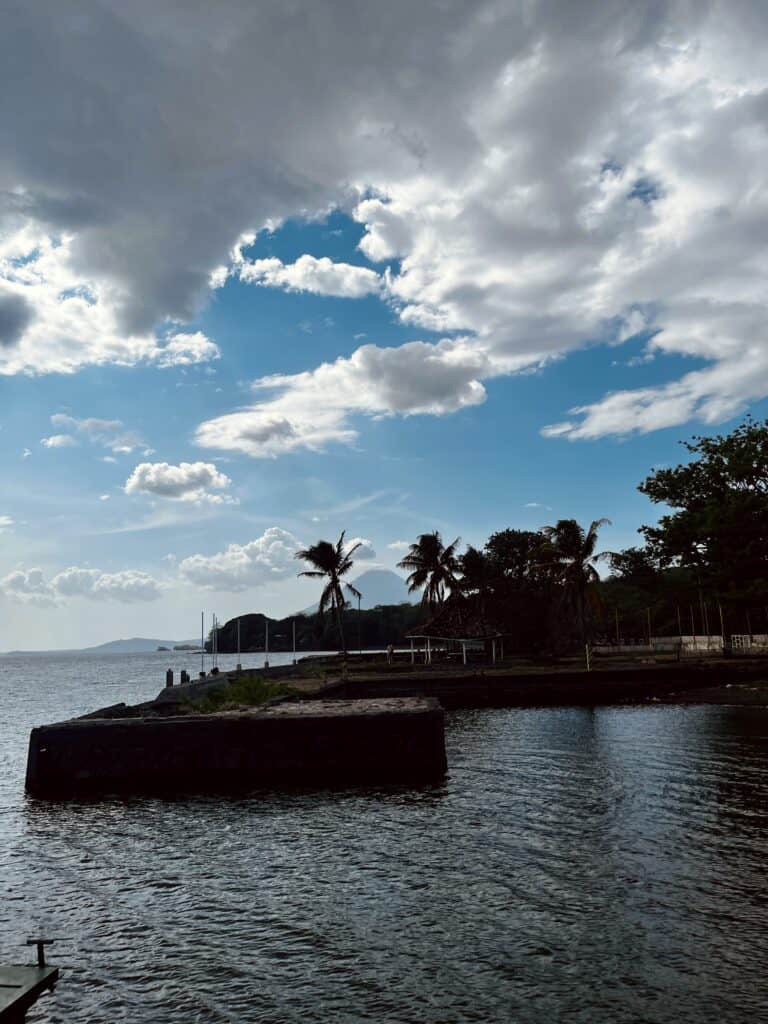
14. Go Kite Surfing on Lake Nicaragua
If you visit between November and April, you’ll see kite surfers flying across Lake Nicaragua, carving through the waves like they’re weightless. The wind conditions are perfect, and Playa Santa Cruz is the main launch point.I was ready to try it, but I was a couple of weeks too late—the season had just ended, and the rental shop had already packed up. If you have the time, Kite Surf Ometepe has amazing reviews, and watching people glide across the water was enough to make me want to come back just to give it a shot.
15. Eat Mangos Straight From the Sand at Playa Mango
Playa Mango is exactly what it sounds like—a quiet beach where ripe mangos literally fall from the trees. No effort required. Just pick one up, wipe off the sand, and eat.
I spent an afternoon here, sitting in the shade, eating fresh mango, and watching Volcán Concepción loom in the distance. The beach is privately owned, but as long as you grab something from the small restaurant, no one cares how long you stay. No crowds, no noise—just lake, sand, and fruit. Simple island life at its best.
16. Drive Around the Island With No Plan
Ometepe isn’t the kind of place that needs an itinerary. Just rent something with wheels and go.
The island has one main highway that loops around, but the real fun is in the detours—dirt paths that lead to empty beaches, jungle roads where you won’t see another soul, views so good you have to pull over. We took an ATV out for a full day, stopping wherever looked interesting, getting lost on purpose.Sometimes the best way to see Ometepe is to forget the plan and just drive.
Where to Stay on Ometepe Island
Where you stay on Ometepe depends on the kind of trip you want. Each area has its own vibe, so pick your base wisely:
- Moyogalpa – Best if you’re arriving late or want easy access to ferries, restaurants, and scooter rentals. It’s the island’s main town, so expect more convenience but less charm.
- Santa Cruz – The go-to for beach lovers, with a relaxed atmosphere near Playa Santo Domingo. Great if you want to swim, eat lakeside, and enjoy Ometepe’s central location.
- Balgüe – Nature-focused and laid-back, this is where you’ll find eco-lodges, yoga retreats, and easy access to Volcán Maderas. Ideal for slow travelers who don’t mind bumpy roads.
- Mérida – Quiet, remote, and near San Ramón Waterfall. If you want a peaceful escape with fewer tourists and don’t mind limited dining options, this is the spot.
Ometepe isn’t about luxury—it’s about nature, adventure, and unplugging. No matter where you stay, you’ll wake up to volcano views, dirt roads, and the sound of howler monkeys in the distance. If you’re planning a trip through Nicaragua, this island deserves a spot on your itinerary
Travel Tips for Ometepe
Ometepe is incredible, but it’s not the kind of place you just show up to unprepared. Here’s what you need to know:
- Bring cash. ATMs are limited, and credit cards aren’t widely accepted—especially in smaller villages.
- Rent an ATV or scooter. It’s the easiest way to get around, and public transport is slow and unreliable.
- Expect rough roads. Some parts of the island feel like they were never meant for vehicles. Be prepared.
- Insect repellent is a must. Mosquitoes, especially near Río Istián, don’t mess around.
- Hydrate and wear sunscreen. The sun is intense, and you’ll feel it—especially when hiking.
- Check ferry schedules. Weather can delay or cancel boats, so plan extra time for your trip.
FAQ – Traveling to Ometepe Nicaragua
Can you do a day trip to Ometepe?
Yes, it’s possible to do a day trip to Ometepe, but you’ll be limited on time. A day trip is ideal for visiting key attractions like Ojo de Agua or Playa Santo Domingo. However, to truly explore the island, a minimum of two days is recommended.
How long to spend in Ometepe?
To fully experience Ometepe, plan to spend at least 3-4 days. This allows enough time to hike one of the volcanoes, visit the waterfalls, and relax at the beaches. If you’re short on time, a two-day visit can still cover the highlights.
What is a good budget for Ometepe?
A good budget for Ometepe depends on your plans. For a day trip, expect to spend around $40, including ferry tickets and scooter rental. If you’re staying overnight, budget an additional $10-$20 per night for accommodation, making a longer visit affordable.
Where to see monkeys in Ometepe?
The best places to see monkeys on Ometepe are in the forests near Volcán Maderas and Charco Verde Nature Reserve. Howler monkeys are common, and you’ll often hear them before you see them, especially in the mornings or late afternoons.
Is Ometepe Island safe?
Ometepe Island is generally very safe for travelers, both day and night. The locals are friendly, and crime rates are low. However, as with any destination, it’s wise to stay aware of your surroundings and follow basic safety precautions.
Can you just book a tour for Ometepe?
Yes, you can book a tour for Ometepe, though it tends to be more expensive than planning independently. Full-day tours from Granada, for example, include transportation, ferry tickets, and an English-speaking guide. Local operators also offer custom tours around the island.
Related Posts
- El Calafate vs. El Chaltén: Which Patagonia Town Should You Choose?
- Costa Rica to Nicaragua Border Crossing: All You Need To Know
- Nicaragua Itinerary: How I Spent a Month Between Beaches, Volcanoes, and ‘Is It Safe?’
- 15+ Incredible Things To Do In Ometepe
- Itinerary for Argentina: Patagonia, Mendoza, and a Bit of Malbec
- How to Hike to Confluencia Base Camp (Without Climbing Aconcagua)
